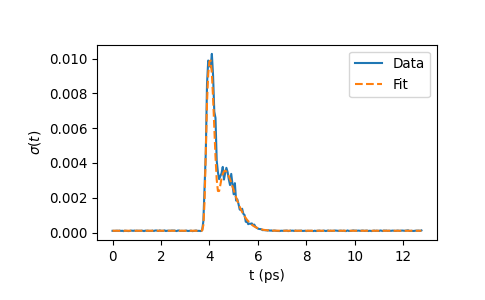thztools.noisefit#
- thztools.noisefit(x, *, dt=None, sigma_alpha0=None, sigma_beta0=None, sigma_tau0=None, mu0=None, a0=None, eta0=None, fix_sigma_alpha=False, fix_sigma_beta=False, fix_sigma_tau=False, fix_mu=False, fix_a=False, fix_eta=False, scale_logv_alpha=None, scale_logv_beta=None, scale_logv_tau=None, scale_delta_mu=None, scale_delta_a=None, scale_eta=None, min_options=None)[source]#
Estimate noise model from a set of nominally identical waveforms.
The data array
xshould include m nominally identical waveform measurements, where each waveform comprises n samples that are spaced equally in time. Thenoise_modelattribute of the return object is an instance of theNoiseModelclass that represents the estimated noise parameters. See Notes for details.- Parameters:
- xarray_like with shape (n, m)
Data array composed of
mwaveforms, each of which is sampled atnpoints.- dtfloat or None, optional
Sampling time, normally in picoseconds. Default is None, which sets the sampling time to
thztools.options.sampling_time. If bothdtandthztools.options.sampling_timeareNone, the sampling time is set to1.0. In this case, the unit of time is the sampling time for the noise model parametersigma_tau, the delay parameter arrayeta, and the initial guesses for both quantities.- sigma_alpha0, sigma_beta0, sigma_tau0float, optional
Initial values for noise parameters. When set to
None, the default, use a linear least-squares fit of the noise model tonp.var(x, 1, ddof=1).- mu0array_like with shape(n,), optional
Initial guess, signal vector with shape (n,). Default is first column of
x.- a0array_like with shape(m,), optional
Initial guess, signal amplitude drift vector with shape (m,). Default is
np.ones(m).- eta0array_like with shape(m,), optional
Initial guess, signal delay drift vector with shape (m,). Default is
np.zeros(m).- fix_sigma_alpha, fix_sigma_beta, fix_sigma_taubool, optional
Fix the associated noise parameter. Default is False.
- fix_mubool, optional
Fix signal vector. Default is False.
- fix_abool, optional
Fix signal amplitude drift vector. Default is False.
- fix_etabool, optional
Fix signal delay drift vector. Default is False.
- Returns:
- resNoiseResult
Fit result represented as a
NoiseResultobject. Important attributes are:noise_model, an instance ofNoiseModelwith the estimated noise parameters;mu, the estimated signal vector;a, the estimated signal amplitude drift vector;eta, the estimated signal delay drift vector;fval, the value of the optimized NLL cost function; anddiagnostic, an instance ofscipy.optimize.OptimizeResultreturned byscipy.optimize.minimize. Note that the fit parameters are scaled internally to improve convergence (see Other Parameters below), which affects the attributesfun,jac, andhess_invofdiagnostic. SeeNoiseResultfor more details and for a description of other attributes.
- Other Parameters:
- scale_logv_alpha, scale_logv_beta, scale_logv_taufloat, optional
Scale for varying the log of the variance parameters.
- scale_delta_muarray_like with shape(n,), optional
Scale for varying signal vector. When set to
None, the default, useNoiseModel(sigma_alpha0, sigma_beta0, sigma_tau0).noise_amp(mu0).- scale_delta_aarray_like with shape(n,), optional
Scale for varying signal amplitude drift vector. Default is
np.max((sigma_min, sigma_beta0))for all entries, wheresigma_min = np.sqrt(np.min(np.var(x, 1, ddof=1))).- scale_etaarray_like with shape(n,), optional
Scale for varying signal delay drift vector. Default is
np.max((sigma_min, sigma_tau0)), for all entries, wheresigma_min = np.sqrt(np.min(np.var(x, 1, ddof=1))).- min_optionsdict or None, optional
Keyword options passed to the
optionsparameter ofscipy.optimize.minimize. See the documentation on the BFGS method for details. By default,gtol=1e-5 * x.size. The optionsepsandfinite_diff_rel_stepare not used.
- Raises:
- ValueError
If all parameters are held fixed or if the input arrays have incompatible shapes.
- Warns:
- UserWarning
If
thztools.options.sampling_timeand thedtparameter are both notNoneand are set to differentfloatvalues, the function will set the sampling time todtand raise aUserWarning.
See also
NoiseModelNoise model class.
Notes
Given an \(N\times M\) data array \(\mathbf{X}\), the function uses the BFGS method of
scipy.optimize.minimizeto minimize the maximum-likelihood cost function [1]\[\begin{split}\ Q_\text{ML}\ (\sigma_\alpha,\sigma_\beta,\sigma_\tau,\boldsymbol{\mu},\ \mathbf{A},\boldsymbol{\eta};\mathbf{X})\ = \frac{1}{2}\sum_{k=0}^{N-1}\sum_{l=0}^{M-1}& \ \left[\ln\sigma_{kl}^2 + \frac{(X_{kl} \ - Z_{kl})^2}{\sigma_{kl}^2}\right]\ \end{split}\]with respect to the unknown model parameters \(\sigma_\alpha\), \(\sigma_\beta\), \(\sigma_\tau\), \(\boldsymbol{\mu}\), \(\mathbf{A}\) and \(\boldsymbol{\eta}\). The model assumes that the elements of \(\mathbf{X}\) are normally distributed around the corresponding elements of \(\mathbf{Z}\) with variances given by \(\boldsymbol{\sigma}^2\), which are in turn given by
\[Z_{kl} = A_l\mu(t_k - \eta_l)\]and
\[\sigma_{kl}^2 = \sigma_\alpha^2 + \sigma_\beta^2 Z_{kl}^2 \ + \sigma_\tau^2(\mathbf{D}\mathbf{Z})_{kl}^2,\]where \(\mathbf{D}\) is the time-domain derivative operator. The function \(\mu(t)\) represents an ideal primary waveform, which drifts in amplitude and temporal location between each of the \(M\) waveform measurements. Each waveform comprises \(N\) samples at the nominal times \(t_k\), and the drift in the amplitude and the temporal location of the \(l\) waveform are given by \(A_l\) and \(\eta_l\), respectively, with initial values fixed at \(A_0 = 1.0\) and \(\eta_0 = 0.0\) by definition.
References
[1]Laleh Mohtashemi, Paul Westlund, Derek G. Sahota, Graham B. Lea, Ian Bushfield, Payam Mousavi, and J. Steven Dodge, “Maximum- likelihood parameter estimation in terahertz time-domain spectroscopy,” Opt. Express 29, 4912-4926 (2021), https://doi.org/10.1364/OE.417724.
Examples
In basic usage, it should be possible to call
noisefitwith just the data array. In the code below, we simulatem = 50noisy waveforms withn = 256time points each, then verify that the fit results are consistent with the true noise parameters.>>> import numpy as np >>> import thztools as thz >>> from matplotlib import pyplot as plt >>> rng = np.random.default_rng(0) >>> n, m, dt = 256, 50, 0.05 >>> t = thz.timebase(n, dt=dt) >>> mu = thz.wave(n, dt=dt) >>> alpha, beta, tau = 1e-4, 1e-2, 1e-3 >>> noise_model = thz.NoiseModel(sigma_alpha=alpha, sigma_beta=beta, ... sigma_tau=tau, dt=dt) >>> a = 1.0 + 1e-2 * np.concatenate(([0.0], ... rng.standard_normal(m - 1))) >>> eta = 1e-3 * np.concatenate(([0.0], rng.standard_normal(m - 1))) >>> z = thz.scaleshift(np.repeat(np.atleast_2d(mu), m, axis=0), dt=dt, ... a=a, eta=eta).T # Orient the array columnwise >>> x = z + noise_model.noise_sim(z, axis=0, seed=12345) >>> noise_res = thz.noisefit(x, sigma_alpha0=alpha, sigma_beta0=beta, ... sigma_tau0=tau, dt=dt) >>> noise_res.noise_model NoiseModel(sigma_alpha=0.000100..., sigma_beta=0.00984..., sigma_tau=0.000899..., dt=0.05)
>>> plt.plot(t, np.std(thz.scaleshift(x, a=1 / noise_res.a, ... eta=-noise_res.eta, axis=0), axis=1), "-", ... label="Data") >>> plt.plot(t, noise_res.noise_model.noise_amp(noise_res.mu), ... "--", label="Fit") >>> plt.legend() >>> plt.xlabel("t (ps)") >>> plt.ylabel(r"$\sigma(t)$") >>> plt.show()
